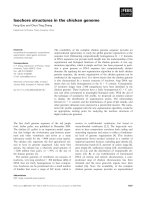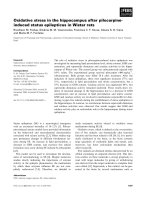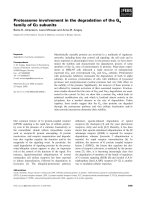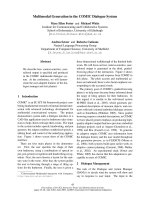Báo cáo khoa học: "Composite paraganglioma-ganglioneuroma in the retroperitoneum" pps
Bạn đang xem bản rút gọn của tài liệu. Xem và tải ngay bản đầy đủ của tài liệu tại đây (503.57 KB, 5 trang )
BioMed Central
Page 1 of 5
(page number not for citation purposes)
World Journal of Surgical Oncology
Open Access
Case report
Composite paraganglioma-ganglioneuroma in the retroperitoneum
Shoji Hirasaki*
1,2
, Hiromitsu Kanzaki
1
, Masato Okuda
1
, Seiyuu Suzuki
1
,
Tetsuji Fukuhara
3
and Toshihito Hanaoka
3
Address:
1
Division of Gastroenterology, Sumitomo Besshi Hospital, 3-1 Ohji-cho, Niihama 7928543, Japan,
2
Division of Gastroenterology, Kubo
Hospital, 1-1-19 Uchibori, Imabari 7992116, Japan and
3
Department of Surgery, Sumitomo Besshi Hospital, 3-1 Ohji-cho, Niihama 7928543,
Japan
Email: Shoji Hirasaki* - ; Hiromitsu Kanzaki - ; Masato Okuda - ;
Seiyuu Suzuki - ; Tetsuji Fukuhara - ;
Toshihito Hanaoka -
* Corresponding author
Abstract
Background: Paragangliomas occur most commonly in head and neck region and much less
frequently, they are found in the retroperitoneum. Composite paraganglioma-ganglioneuroma of
the retroperitoneum is very rare.
Case presentation: We present an unusual case of retroperitoneal composite paraganglioma-
ganglioneuroma discovered on computed tomography in a 63-year-old female patient. Routine
hematological examination and biochemical tests were within normal limits. Plasma adrenaline was
0.042 ng/ml, plasma noradrenaline 0.341 ng/ml, and plasma dopamine <0.01 ng/ml. An abdominal
contrast-enhanced CT scan and magnetic resonance imaging revealed a 6.5 cm heterogeneous
retroperitoneal mass with a cystic component. The retroperitoneal tumor accumulated
131
I-
Metaiodobenzylguanidine (
131
I-MIBG) 48 hours after radioisotope injection. Under the diagnosis of
paraganglioma in the retroperitoneum, the patient underwent surgery. The resected tumor (6.5 ×
5 × 3 cm) was solid and easily removed en bloc. The cut surface of the tumor and histology revealed
two different components in the tumor: paraganglioma centrally and ganglioneuroma on the
periphery. She remains disease-free 18 months after surgery.
Conclusion: This case reminds us that neuroendocrine tumor should be included in the
differential diagnosis of a retroperitoneal mass although composite paraganglioma-ganglioneuroma
in the retroperitoneum is very rare.
Background
Pheochromocytomas arising from outside the adrenal
glands are called paragangliomas [1] and constitute a rel-
atively rare disease, arising from undifferentiated cells of
the primitive neural crest [2,3]. Paragangliomas occur
most commonly in head and neck region [4], and much
less frequently, they are found in the retroperitoneum [3].
Extraadrenal paragangliomas, which account for 5-10% of
these tumors, are found in the retroperitoneum, thorax,
and urinary bladder [5]; composite tumor of the retroper-
itoneum is rare. To our knowledge, at least 4 cases of com-
posite paraganglioma-ganglioneuroma in the urinary
bladder have been reported [5-7]; however, there have
been only few reports of retroperitoneal composite para-
Published: 5 November 2009
World Journal of Surgical Oncology 2009, 7:81 doi:10.1186/1477-7819-7-81
Received: 23 August 2009
Accepted: 5 November 2009
This article is available from: />© 2009 Hirasaki et al; licensee BioMed Central Ltd.
This is an Open Access article distributed under the terms of the Creative Commons Attribution License ( />),
which permits unrestricted use, distribution, and reproduction in any medium, provided the original work is properly cited.
World Journal of Surgical Oncology 2009, 7:81 />Page 2 of 5
(page number not for citation purposes)
ganglioma-ganglioneuroma. Herein, we report an unu-
sual case of composite paraganglioma-ganglioneuroma in
the retroperitoneum successfully treated with surgery.
Case presentation
The patient was a 63-year-old-woman, 158 cm tall and
weighing 62 kg. She was admitted to our hospital for left
femoral shaft fracture. She underwent an abdominal con-
trast-enhanced CT scan because she developed left leg
edema and was suspected of suffering deep vein thrombo-
sis of the lower extremity, and a large retroperitoneal mass
was discovered. She had no abdominal symptoms, had
been in good health, and had no specific family, past
medical, or drug history. She had not complained of
headache and had no history of hypertension. Routine
hematological examination and biochemical tests were
within normal limits. Plasma adrenaline was 0.042 ng/ml
[normal range (NR): <0.07], plasma noradrenaline 0.341
ng/ml (NR: 0.06-0.46), and plasma dopamine <0.01 ng/
ml (NR: <0.014). Regarding tumor markers, carbohydrate
antigen 19-9, carcinoembryonic antigen (CEA) and alpha
fetoprotein (AFP) were all negative. An abdominal con-
trast-enhanced CT scan (Fig. 1) and magnetic resonance
imaging (MRI) (Fig. 2) revealed a 6.5 cm heterogeneous
retroperitoneal mass with a cystic component. MRI
showed a high intensity tumor with signal intensity
greater than that of the liver and central higher signal
intensity on T2-weighted images.
131
I-Metaiodobenzyl-
guanidine (
131
I-MIBG) scintigraphic scan tomography
was performed and the retroperitoneal tumor accumu-
lated
131
I-MIBG 48 hours after radioisotope injection (Fig.
3). Her deep vein thrombosis seemed to be caused by con-
gestion and movement limit due to bone fracture and had
no connection with retroperitoneal mass because her leg
edema improved before abdominal surgery. Under the
diagnosis of paraganglioma in the retroperitoneum, the
patient underwent surgery. The resected tumor (6.5 × 5 ×
3 cm) was solid and easily removed en bloc. The tumor
An abdominal contrast-enhanced CT scan incidentally dem-onstrated a heterogeneous mass, 6.5 cm in diameter, with cystic lesion in the retroperitoneumFigure 1
An abdominal contrast-enhanced CT scan inciden-
tally demonstrated a heterogeneous mass, 6.5 cm in
diameter, with cystic lesion in the retroperitoneum.
The tumor exhibited marked enhancement after intravenous
administration of contrast material.
T2-weighted magnetic resonance images revealed a high intensity tumor those signal intensity was greater than that of the liver with central higher signal intensityFigure 2
T2-weighted magnetic resonance images revealed a
high intensity tumor those signal intensity was
greater than that of the liver with central higher sig-
nal intensity.
131
I-Metaiodobenzylguanidine (
131
I-MIBG) scintigraphic scan tomography showed
131
I-MIBG accumulation in the retro-peritoneal tumorFigure 3
131
I-Metaiodobenzylguanidine (
131
I-MIBG) scinti-
graphic scan tomography showed
131
I-MIBG accumu-
lation in the retroperitoneal tumor.
World Journal of Surgical Oncology 2009, 7:81 />Page 3 of 5
(page number not for citation purposes)
appeared grossly encapsulated on its external surface (Fig.
4). The cut surface showed two distinct components:
brown-red lesion with a cyst and a whitish area account-
ing for 10% of the tumor (Fig. 5, Fig. 6A). The tumor had
no necrosis or hemorrhage. Histological examination of
the brown-red lesion with a cyst revealed well-defined
nests of neoplastic cells containing finely granular cyto-
plasm and enlarged nuclei referred to as 'Zellballen' (Fig.
6B). Several tumor cells had eosinophilic hyaline globules
in the cytoplasm. These neoplastic cells were positive for
chromogranin A, synaptophysin and Grimelius stain. A
population of S-100-positive sustentacular cells that were
present at the peripheries of the cell nests was seen. This
lesion was diagnosed as paraganglioma. Paraganglioma
had <1% of MIB-1-positive cells. Histological examina-
tion of the whitish area revealed the proliferation of spin-
dle shaped Schwann cells and a small number of ganglion
cells, characterized by plump cytoplasm (Fig 6C). Immu-
nohistochemical staining revealed positive immunoreac-
tivity for S-100 protein in these cells. Cells of each
component were well differentiated and no mitosis was
observed. There was no evidence of malignancy. The
tumor was composed of approximately 90% paragangli-
oma and 10% ganglioneuroma. Focal interminglings of
the two components were noted; however, two compo-
nents were separated in the greater part of the tumor.
Abrupt transition of two different components of para-
ganglioma and ganglioneuroma was seen. The diagnosis,
based on these histological findings, was composite para-
ganglioma-ganglioneuroma in the retroperitoneum. The
postoperative course was uneventful and no additional
therapy was given according to informed consent. She has
been under close periodic observation and there is no evi-
dence of this disease 18 months after surgery.
Discussion
The paraganglia are widely dispersed collections of spe-
cialized neural crest cells that lie adjacent to the sympa-
thetic ganglia and plexuses throughout the body. The
paraganglionic system includes the adrenal medulla, the
chemoreceptors, vagal body, and small groups of cells
associated with the thoracic as well as intraabdominal and
retroperitoneal ganglia [8]. Tumors that arise from chro-
maffin cells of the adrenal medulla are called pheochro-
mocytomas, whereas those that occur in paraganglia at
other sites are referred to as paragangliomas [9]. Gangli-
oneuroma is a benign neoplasm composed of Schwann
cells and ganglion cells. The most affected anatomical
sites are the posterior mediastinum, retroperitoneum,
adrenal gland and head and neck soft tissue [10]. Solitary
ganglioneuromas most commonly occur in infants and
young children, slightly more often in girls than boys,
with a female-to-male ratio of about 3:1 [11]. The major-
ity is diagnosed before the patient is 10 years of age.
Paraganglioma shows marked contrast enhancement on
contrast-enhanced CT scan [12,13]. MRI can be used to
help to locate a paraganglioma; however, only about 80%
of T2-weighted MRI studies will show the characteristic
uniform high-signal-intensity image because the presence
of internal hemorrhage may reduce signal intensity [9]. In
the present case, diagnostic images obtained by contrast-
enhanced CT scan, MRI and
131
I-MIBG scintigraphic scan
tomography were compatible with paraganglioma. But we
could not diagnose this tumor as composite paragangli-
oma-ganglioneuroma.
Paraganglioma-ganglioneuroma is a rare composite
tumor, and at least one case of extra-adrenal retroperito-
neal ganglioneuroma-pheochromocytoma has been
Macroscopic finding of the tumorFigure 4
Macroscopic finding of the tumor. The resected tumor,
6.5 × 5 × 3 cm, was encapsulated on its external surface.
The cut surface showed two different components including a brown-red lesion with a cyst and a whitish lesion (arrows)Figure 5
The cut surface showed two different components
including a brown-red lesion with a cyst and a whitish
lesion (arrows).
World Journal of Surgical Oncology 2009, 7:81 />Page 4 of 5
(page number not for citation purposes)
reported [14]. Usuda et al reviewed 4 patients with para-
ganglioma-ganglioneuroma in the urinary bladder [6]. All
4 patients were older than 40 years of age (range, 49-81
years), 3 of 4 patients with composite tumor were women,
and 2 patients had a symptom of headache. They reported
that it was difficult to predict the clinical behavior of com-
posite tumors. These 4 reported cases of composite para-
ganglioma-ganglioneuromas in the urinary bladder
showed no malignant features such as extra-bladder infil-
tration or metastasis. The natural history of composite
paraganglioma-ganglioneuromas remains unclear. Thus,
accumulation of long-term follow-up cases may provide
valuable prognostic information on this composite
tumor. The pathogenesis of composite paraganglioma-
ganglioneuroma also remains unknown. Although we
could not make a conclusive remark, we thought that the
tumor might be a collision tumor because two compo-
nents (paraganglioma and ganglioneuroma) were sepa-
rated in the greater part of the tumor and transitional zone
was not recognized in the present case.
It is not possible to differentiate benign from malignant
paraganglioma confidently with imaging alone. With the
exception of the presence of distant metastases, there are
no absolute criteria for malignancy in paragangliomas.
However, features more frequently noted in malignant
tumors are extraadrenal location, greater tumor weight,
confluent necrosis, and the presence of vascular invasion
and/or extensive local invasion [5]. According to Hayes et
al [15], malignant paragangliomas tend to be large and
their four cases had average diameter of 13.8 cm (range,
10.7-17.0). Thus a tumor size of larger than 10 cm may be
indicative of malignant behavior. Assessing the prolifera-
tive index seems to be important, because all of the ana-
lyzed benign tumors showed <1% of MIB-1-positive cells
[16].
In the present case, there were no histological features sug-
gesting malignancy, and MIB-1-positive cells were <1%;
however, we should be attentive to recurrence in this case.
Sclafani et al found that 11 of 22 (50%) retroperitoneal
paragangliomas metastasized to distant organs [17] and 2
of 11 (18%) patients developed their first metastases
more than 7 years after diagnosis; thus, a longer follow-up
is needed for this disease.
Retroperitoneal paraganglioma is treated in principle by
surgical resection. Composite paraganglioma-ganglioneu-
roma in the retroperitoneum is very rare. However, as
probably most of the retroperitoneal paragangliomas are
benign, it is likely that there are patients with latent retro-
peritoneal paraganglioma, which may be incidentally dis-
covered in the future as a result of advances in diagnostic
imaging, such as improved CT and MRI.
Conclusion
Although composite paraganglioma-ganglioneuroma in
the retroperitoneum is not common, the possibility of a
neuroendocrine tumor should be considered in the differ-
ential diagnosis of a retroperitoneal mass. When a large
retroperitoneal mass is incidentally found by diagnostic
imaging, it should be carefully examined and resection
should be considered, especially in patients with tumor
size of larger than 10 cm.
Consent
Written informed consent was obtained from the patient
for publication of this case report and accompanying
images. A copy of the written consent is available for
review by the Editor-in-Chief of this journal.
Competing interests
The authors declare that they have no competing interests.
Authors' contributions
SH and HK reviewed the literature and wrote the case pres-
entation, SH, HK, MO, SS were involved in the care of the
patient, TF and TH performed surgical management. All
authors read and approved the final manuscript.
Microscopic findings of the tumorFigure 6
Microscopic findings of the tumor. (A) Two different
components were recognized in the tumor. (B) Histological
examination of the brown-red lesion with a cyst demonstrat-
ing a nest of neoplastic cells (Zellballen) containing finely
granular cytoplasm and enlarged nuclei. (HE stain × 200). (C)
The whitish lesion revealed the intersecting bundles of
Schwann cells contained scattered ganglion cells. The gan-
glion cells had plump cytoplasm (HE stain × 100).
Publish with BioMed Central and every
scientist can read your work free of charge
"BioMed Central will be the most significant development for
disseminating the results of biomedical research in our lifetime."
Sir Paul Nurse, Cancer Research UK
Your research papers will be:
available free of charge to the entire biomedical community
peer reviewed and published immediately upon acceptance
cited in PubMed and archived on PubMed Central
yours — you keep the copyright
Submit your manuscript here:
/>BioMedcentral
World Journal of Surgical Oncology 2009, 7:81 />Page 5 of 5
(page number not for citation purposes)
Acknowledgements
The authors are deeply grateful to Dr Atsuko Shirakawa, Department of
Pathology, Sumitomo Besshi Hospital, for her assistance in the pathological
study.
References
1. Kimura S, Iwai M, Fukuda T, Akamatsu T, Ochi F, Masugi J, Nakano O,
Sakamoto T, Fukunaga H, Amano M, Fujimori T, Maeda S: Combina-
tion chemotherapy for malignant paraganglioma. Intern Med
1997, 36:35-39.
2. Crozier F, Lechevallier E, Eghazarian C, André M, Sammama D, Wil-
shire P, Vidal V, Pascal P, Bartoli JM: Retroperitoneal non-secret-
ing paraganglioma. J Radiol 1999, 80:150-152. (in French with
English abstract)
3. Matsui H, Ikeuchi S, Onoda N, Tsutsumi Y: Malignant paragangli-
oma of the retroperitoneum with lung metastases: a 13-year
survivor after radical surgery. Asian J Surg 2007, 30:75-79.
4. Olson JR, Abell MR: Nonfunctional, nonchromaffin paragangli-
oma of the retroperitoneum. Cancer 1969, 23:1358-1367.
5. Dundr P, Dudorkinová D, Povýsil C, Pesl M, Babjuk M, Dvorácek J,
Zelinka T: Pigmented composite paraganglioma-ganglioneu-
roma of the urinary bladder. Pathol Res Pract 2003, 199:765-769.
6. Usuda H, Emura I: Composite paraganglioma-ganglioneuroma
of the urinary bladder. Pathol Int 2005, 55:596-601.
7. Lam KY, Loong F, Shek TW, Chu SM: Composite paraganglioma-
ganglioneuroma of the urinary bladder: a clinicopathologic,
immunohistochemical, and ultrastructural study of a case
and review of the literature. Endocr Pathol 1998, 9:353-361.
8. Enzinger FM, Weiss SW: Soft tissue tumors 2nd edition. St Louis, Mo:
Mosby-Year Book; 1988:719-860.
9. Rha SE, Byun JY, Jung SE, Chun HJ, Lee HG, Lee JM: Neurogenic
tumors in the abdomen: tumor types and imaging character-
istics. Radiographics 2003, 23:29-43.
10. Ponce-Camacho MA, Diaz de Leon-Medina R, Miranda-Maldonado I,
Garza-Guajardo R, Hernandez-Salazar J, Barboza-Quintana O: A 5-
year-old girl with a congenital ganglioneuroma diagnosed by
fine needle aspiration biopsy: A case report. Cytojournal 2008,
5:5.
11. Joshi VV: Peripheral neuroblastic tumors: pathologic classifi-
cation based on recommendations of international neurob-
lastoma pathology committee (Modification of shimada
classification).
Pediatr Dev Pathol 2000, 3:184-199.
12. Flint EW, Claassen D, Pang D, Hirsch WL: Intrasellar and supra-
sellar paraganglioma: CT and MR findings. Am J Neuroradiol
1993, 14:1191-1193.
13. Patel SR, Winchester DJ, Benjamin RS: A 15-year experience with
chemotherapy of patients with paraganglioma. Cancer 1995,
76:1476-1480.
14. Tanaka T, Yoshimi N, Iwata H, Sugie S, Kato K, Sakamoto H, Mori H:
Fine needle aspiration cytology of pheochromocytoma-gan-
glioneuroma of the organ of Zuckerkandl. Diagn. Cytopathol
1989, 5:64-68.
15. Hayes WS, Davidson AJ, Grimley PM, Hartman DS: Extraadrenal
retroperitoneal paraganglioma: clinical, pathologic, and CT
findings. AJR Am J Roentgenol 1990, 155:1247-1250.
16. Elder EE, Xu D, Höög A, Enberg U, Hou M, Pisa P, Gruber A, Larsson
C, Bäckdahl M: Ki-67 AND hTERT expression can aid in the
distinction between malignant and benign pheochromocy-
toma and paraganglioma. Mod Pathol 2003, 16:246-255.
17. Sclafani L, Woodruff J, Brennan M: Extraadrenal retroperitoneal
paragangliomas: natural history and response to treatment.
Surgery 1990, 108:1124-1130.









